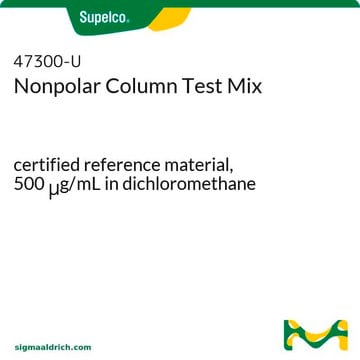33065-U
Sylon CT™
for GC derivatization, pkg of 400 mL, 5% dimethyldichlorosilane in toluene
Synonym(s):
Dichlorodimethylsilane solution, Dimethyldichlorosilane solution
About This Item
Recommended Products
grade
for GC derivatization
description
Silyl reagent
packaging
pkg of 400 mL
concentration
5% dimethyldichlorosilane in toluene
SMILES string
C[Si](C)(Cl)Cl
InChI
1S/C2H6Cl2Si/c1-5(2,3)4/h1-2H3
InChI key
LIKFHECYJZWXFJ-UHFFFAOYSA-N
Looking for similar products? Visit Product Comparison Guide
General description
Treat the glass tubing that you use for columns with Sylon-CT solution (5% dimethyldichlorosilane in toluene). It deactivates the tubing for use up to 350 °C to 400 °C, far exceeding the capabilities of other deactivating agents used at room temperature. Sylon CT™ also deactivates transfer lines and glass or glass-lined injection port liners. Instructions included.
Application
Legal Information
related product
Signal Word
Danger
Hazard Statements
Hazard Classifications
Aquatic Chronic 3 - Asp. Tox. 1 - Eye Dam. 1 - Flam. Liq. 2 - Repr. 2 - Skin Corr. 1A - STOT RE 2 - STOT SE 3
Target Organs
Central nervous system
Supplementary Hazards
Storage Class Code
3 - Flammable liquids
WGK
WGK 3
Flash Point(F)
39.2 °F - closed cup
Flash Point(C)
4 °C - closed cup
Personal Protective Equipment
Choose from one of the most recent versions:
Already Own This Product?
Find documentation for the products that you have recently purchased in the Document Library.
Our team of scientists has experience in all areas of research including Life Science, Material Science, Chemical Synthesis, Chromatography, Analytical and many others.
Contact Technical Service










